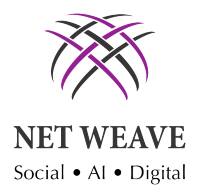The internet can be a ruthless place, especially for companies looking to hold a conversation on social media platforms. One minute you’re posting a funny cat photo and the next you’ve got a never ending string of comments from disgruntled fans. See the connection? Yeah, we don’t either. Welcome to the fun world of social media management. A world where you never quite know which campaigns will be a huge hit and which posts will go over like a lead balloon.
Anyone who manages a Facebook, Twitter, Instagram, Vine, YouTube or Pinterest account for a business knows the struggles of online customer service. When a customer is right in front of you it’s easier to gauge their emotional investment and gain control of the situation. Put that customer behind a computer screen and suddenly figuring out what exactly they want from you is ten times more difficult. A good Community Manager will make it a priority to find the right way to post for their particular audience and will also figure out when and how to respond to fans. But a GREAT Community Manager will know when to admit when a mistake has been made and take the proper steps to set things straight.
Whether you’re a Social Media newbie or a seasoned professional, learning from your posting mistakes is the first step to success. Unless of course you can learn from OTHER people’s mistakes… in which case you should definitely do the latter. 😉
We’ve compiled a list of some of the biggest social media blunders made by both large and small businesses alike. Be sure to take notes- these can all be added to your mental “Do Not Do” list:
1) US Airways pornographic tweet
US Airways accidentally tweeted a pornographic image, which involved a lady with a ‘toy’ airplane, causing a social media outrage! (We can’t even run the image blurred out, it’s that bad.) It took the airline company an hour to remove the image. According to the company, they had copied the image to their clipboard when reporting the image to Twitter, and inadvertently pasted it in a message instead.
The Takeaway- Always double check your photos before posting/tweeting/gramming etc.
2) Delta Airlines uses an image of a giraffe to represent Ghana
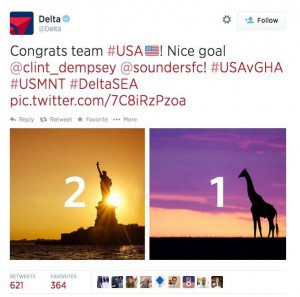 In an attempt to congratulate the US Team on their win against Ghana during the World Cup, Delta posted a photo using a giraffe to represent Ghana. Unfortunately for Delta, giraffes are not native to Ghana, and internet users were quick to comment on Delta’s geographical ignorance.
In an attempt to congratulate the US Team on their win against Ghana during the World Cup, Delta posted a photo using a giraffe to represent Ghana. Unfortunately for Delta, giraffes are not native to Ghana, and internet users were quick to comment on Delta’s geographical ignorance.
The Takeaway– Don’t make assumptions. When in doubt, research!
3) United Airlines breaks musician David Carrol’s guitar
After arriving at his destination, musician David Carrol realized United Airlines baggage handlers had damaged his $3500 guitar. He warned the Airline that if nothing was done he would write a hit song and post it on YouTube. The video he posted about United Airlines breaking guitars went viral, a documentary was made, and even a book got published.
The Takeaway– Never underestimate your fans. Do what you can to make things right when a customer has a negative experience.
4) Kmart responds with hundreds of automated tweets
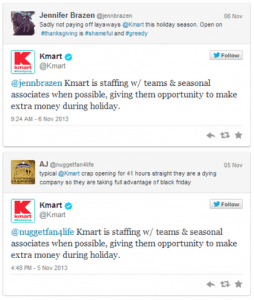 After announcing they were open earlier on Thanksgiving and would stay open through all of Black Friday, people tweeted their disapproval of Kmart’s lack of ethics. Kmart responded to every single complaint with the same impersonal “corporate” response, which only made things worse.
After announcing they were open earlier on Thanksgiving and would stay open through all of Black Friday, people tweeted their disapproval of Kmart’s lack of ethics. Kmart responded to every single complaint with the same impersonal “corporate” response, which only made things worse.
The Takeaway– Personalized responses to angry or disgruntled fans will go a much longer way than a “corporate” automated response.
5) Home Depot’s “racist” College Game Day tweet
No one is sure whether this particular tweet was racist or just plain stupid. Either way, Home Depot was accused of racism and was forced to remove the tweet, apologize and fire the social media agency responsible.
The Takeaway– If the post walks a fine line or can have a negative connotation, chances are your followers will exploit it.
6) London Luton Airport’s uses a plane crash photo on their Facebook post
In order to make themselves seem like a better airport, London Luton decided to use a photo of a Chicago flight that had slid off the runway in order to market themselves. Turns out the incident pictured had resulted in the death of a six year old boy, and the airport received a firestorm of criticism for its lack of sensitivity.
The Takeaway– Never use the failure of another brand in order to promote your own. Also, do your research.
7) Amy’s Baking Company yells at fans on Facebook and Yelp… repeatedly
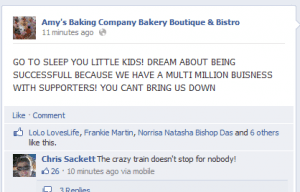 After being featured in a pretty outrageous episode of Gordon Ramsay’s “Kitchen Nightmares.” the owners of Amy’s Baking Company took out their anger on Facebook. After multiple psychotic and cringeworthy rants the couple claimed that their social media had been “hacked”. By then, the damage had been done and no one believed them.
After being featured in a pretty outrageous episode of Gordon Ramsay’s “Kitchen Nightmares.” the owners of Amy’s Baking Company took out their anger on Facebook. After multiple psychotic and cringeworthy rants the couple claimed that their social media had been “hacked”. By then, the damage had been done and no one believed them.
The Takeaway– Don’t use all caps. Don’t insult your followers. Don’t act crazy. Don’t post long rants. Don’t make fun of Gordon Ramsey. Don’t bring God into the mix.
8) McDonald’s #McDstories campaign goes terribly wrong
In an attempt to spark a series of positive comments about their brand, McDonald’s created the #McDstories hashtag campaign asking people to share their experiences with McDonalds on Social Media. Unfortunately the hashtag quickly became a “bashtag” as hundreds of users tweeted negative comments and experiences instead of positive ones.
The Takeaway– Don’t assume people have amazing things to say about your company and have a backup plan in case things don’t go the way you planned.
9) AT&T’s “Never Forget” Twitter photo
On September 11th, AT&T posted this photo to Twitter causing a social outrage. The company quickly removed the image and apologized. Much to their dismay, many Twitter users attacked their apology as well, with some even saying they were going to switch to Sprint instead.
The Takeaway- Never use a tragedy as an opportunity for shameless self promotion.
10) Kellogg’s Hungry Kids Breakfast Campaign
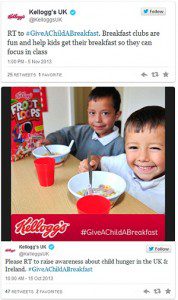 The cereal manufacturer posted the tweet “1 RT = 1 breakfast for a vulnerable child” as part of it’s “Give A Child Breakfast” campaign. It was met with harsh criticism on social media with many users bashing the company for withholding breakfast from children unless they had enough retweets. Kellogg’s removed the tweet and apologized, but it still left a bad taste in the mouths of fans.
The cereal manufacturer posted the tweet “1 RT = 1 breakfast for a vulnerable child” as part of it’s “Give A Child Breakfast” campaign. It was met with harsh criticism on social media with many users bashing the company for withholding breakfast from children unless they had enough retweets. Kellogg’s removed the tweet and apologized, but it still left a bad taste in the mouths of fans.
The Takeaway– Don’t ever trade social media engagement for an act of kindness. Guilt tripping your customers is never a good strategy.
